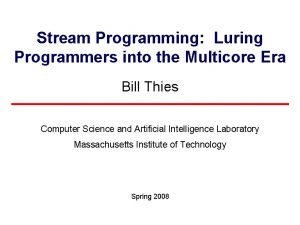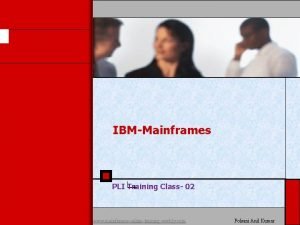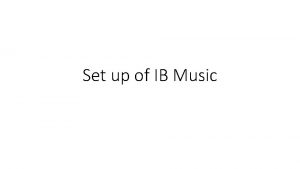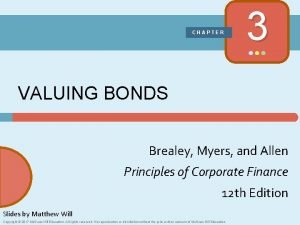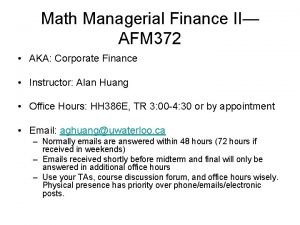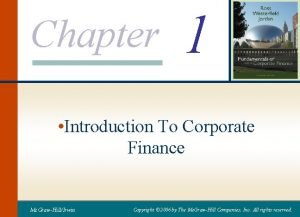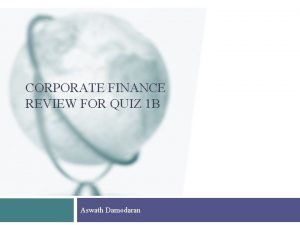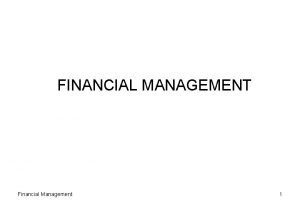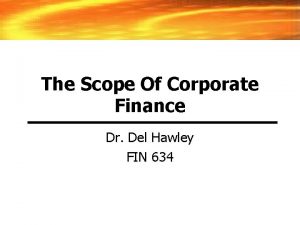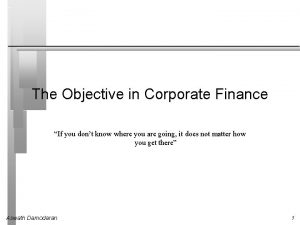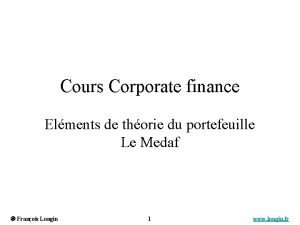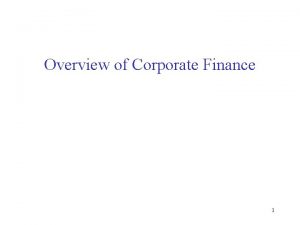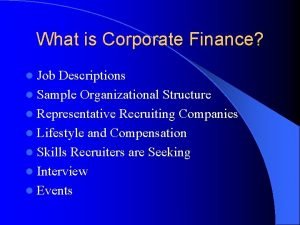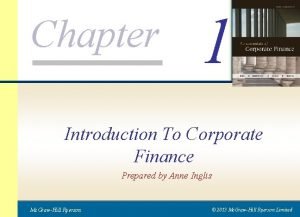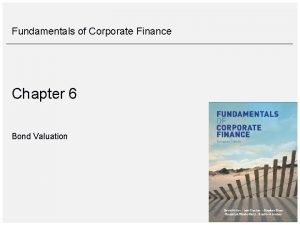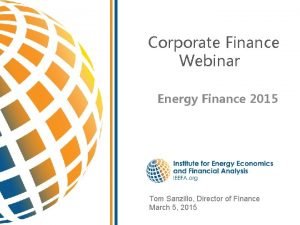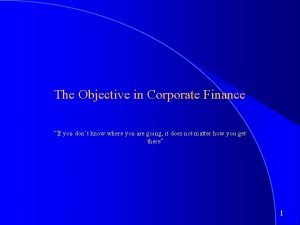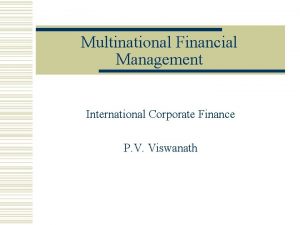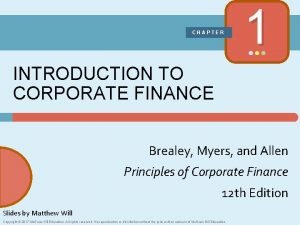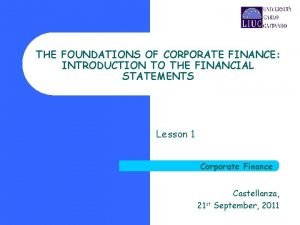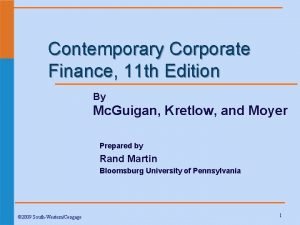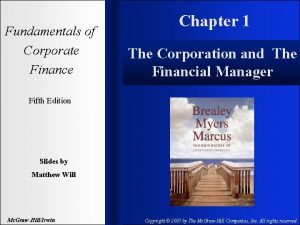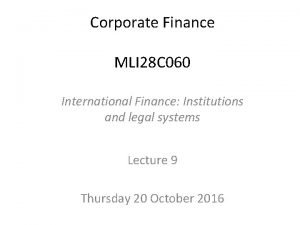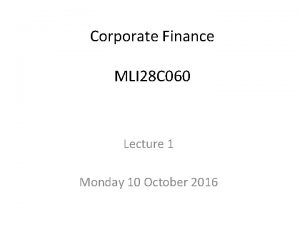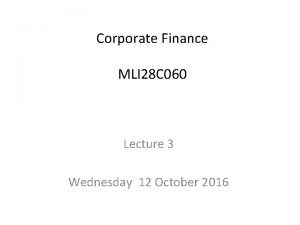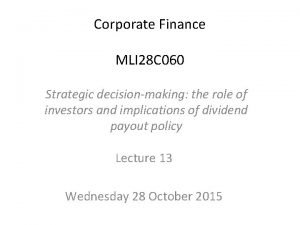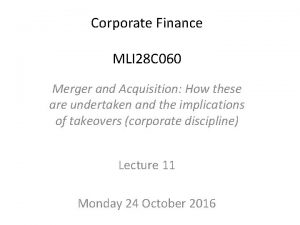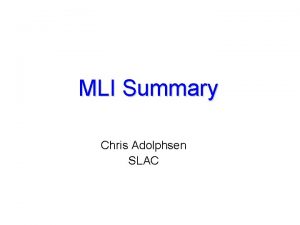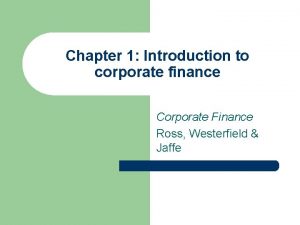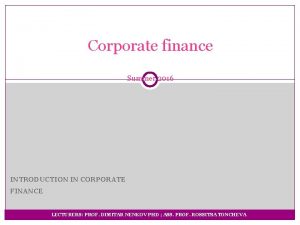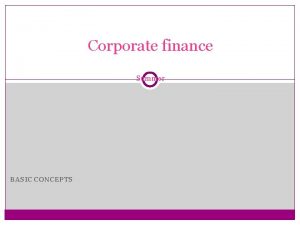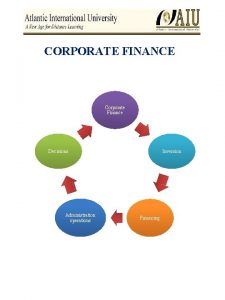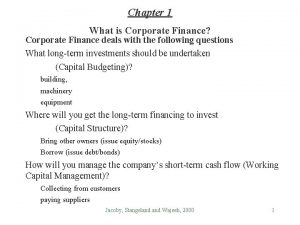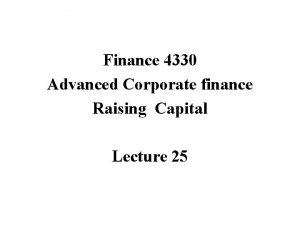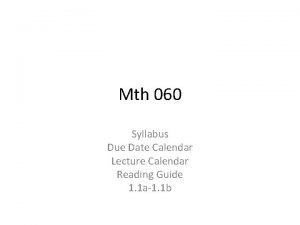Corporate Finance MLI 28 C 060 Lecture 2















































- Slides: 47

Corporate Finance MLI 28 C 060 Lecture 2 Tuesday 11 October 2016

Interest Rate Parity (IRP) • Interest rate parity theory provides the linkage between foreign exchange markets and international money markets • The theory states that the difference in the national interest rates for securities of similar risk and maturity should be equal to, but opposite sign to, the forward rate discount or premium for the foreign currency, except for transaction costs

Interest Rate Parity (IRP) – In the diagram in the following slide, a US dollarbased investor with $1 million to invest, is shown indifferent between dollar-denominated securities for 90 days earning 8. 00% per annum, or Swiss franc-denominated securities of similar risk and maturity earning 4. 00% per annum, when “cover” against currency risk is obtained with a forward contract

Figure 2: Interest Rate Parity (IRP)

Covered Interest Arbitrage (CIA) • Because the spot and forward markets are not always in a state of equilibrium as described by IRP, the opportunity for arbitrage exists • The arbitrageur who recognizes this imbalance can invest in the currency that offers the higher return on a covered basis • This is known as covered interest arbitrage (CIA) • The following slide describes a CIA transaction in much the same way as IRP was transacted

Figure 3: Covered Interest Arbitrage (CIA)

Covered Interest Arbitrage (CIA) • A deviation from CIA is uncovered interest arbitrage, UIA, wherein investors borrow in currencies exhibiting relatively low interest rates and convert the proceeds into currencies which offer higher interest rates • The transaction is “uncovered” because the investor does not sell the currency forward, thus remaining uncovered to any risk of the currency deviating

Covered Interest Arbitrage (CIA) • Rule of Thumb: – If the difference in interest rates is greater than the forward premium (or expected change in the spot rate), invest in the higher yielding currency. – If the difference in interest rates is less than the forward premium (or expected change in the spot rate), invest in the lower yielding currency.

Figure 4: Uncovered Interest Arbitrage (UIA): The Yen Carry Trade

Figure 5: Interest Rate Parity (IRP) and Equilibrium

Forward Rates as an Unbiased Predictor • If the foreign exchange markets are thought to be “efficient” then the forward rate should be an unbiased predictor of the future spot rate • This is roughly equivalent to saying that the forward rate can act as a prediction of the future spot exchange rate, and it will often “miss” the actual future spot rate, but it will miss with equal probabilities (directions) and magnitudes (distances)

Figure 6: Forward Rate as an Unbiased Predictor for Future Spot Rate

Definition of foreign exchange exposure

Types of Foreign Exchange Exposure • There are three distinct types of foreign exchange exposures that global firms may face as a result of their international activities. • These foreign exchange exposures are: – Transaction exposure • Any MNC engaged in current transactions involving foreign currencies. – Economic exposure • Results for future and unknown transactions in foreign currencies resulting from a MNC long term involvement in a particular market. – Translation exposure (sometimes called “accounting” exposure). • Important for MNCs with a physical presence in a foreign country. • We will develop each of these in the slides which follow.

Figure. Conceptual Comparison of Transaction, Operating, and Translation Foreign Exchange Exposure

Hedging and Exposure - Risk https: //www. youtube. com/watch? v=k. Btrx. Ajt. G 04

Why Hedge? • Hedging protects the owner of an asset (future stream of cash flows) from loss • However, it also eliminates any gain from an increase in the value of the asset hedged against • Since the value of a firm is the net present value of all expected future cash flows, it is important to realize that variances in these future cash flows will affect the value of the firm and that at least some components of risk (currency risk) can be hedged against

Why Hedge - the Pros & Cons • Proponents of hedging give the following reasons: – Reduction in risk in future cash flows improves the planning capability of the firm – Reduction of risk in future cash flows reduces the likelihood that the firm’s cash flows will fall below a necessary minimum – Management has a comparative advantage over the individual investor in knowing the actual currency risk of the firm – Markets are usually in disequilibirum because of structural and institutional imperfections

FX Exposure and the Valuation of a MNC • where E(CF$, t) represents expected cash flows to be received at the end of period t, • n represents the number of periods into the future in which cash flows are received, and • k represents the required rate of return by investors.

Impact of Foreign Exchange Exposure • where CFj, t represents the amount of cash flow denominated in a particular foreign currency j at the end of period t, • Sj, t represents the exchange rate at which the foreign currency (measured in dollars per unit of the foreign currency) can be converted to dollars at the end of period t.

Figure. Impact of Hedging on the Expected Cash Flows of the Firm

Hedging Strategies • It appears that most MNC firms (except for those involved in currency-trading) would prefer to hedge their foreign exchange exposures. • But, how can firms hedge? – (1) Financial Contracts • Forward contracts (also futures contracts) • Options contracts (puts and calls) • Borrowing or investing in local markets. – (2) Operational Techniques • Geographic diversification (spreading the risk)

Example – BREXIT and EUR/GBP exchange rate

Introduction of 4 principle methods to hedge exposure (unhedged, forward contracts, money markets, simple currency options)

Trident’s Transaction Exposure Managing an Account Receivable • Maria Gonzalez, CFO of Trident, has just concluded a sale to Regency, a British firm, for £ 1, 000 • The sale is made in March for settlement due in three months time, June – Assumptions • • • Spot rate is $1. 7640/£ 3 month forward rate is $1. 7540/£ (a 2. 2676% discount) Trident’s cost of capital is 12. 0% UK 3 month borrowing rate is 10. 0% p. a. UK 3 month investing rate is 8. 0% p. a.

Trident’s Transaction Exposure Managing an Account Receivable – Assumptions • US 3 month borrowing rate is 8. 0% p. a. • US 3 month investing rate is 6. 0% p. a. • June put option in OTC market for £ 1, 000; strike price $1. 75; 1. 5% premium • Trident’s foreign exchange advisory service forecasts future spot rate in 3 months to be $1. 7600/£ • Trident operates on thin margins and Maria wants to secure the most amount of US dollars; her budget rate (lowest acceptable amount) is $1. 7000/£

Trident’s Transaction Exposure Managing an Account Receivable • Maria faces four possibilities: – Remain unhedged – Hedge in the forward market – Hedge in the money market – Hedge in the options market

Trident’s Transaction Exposure Managing an Account Receivable • Unhedged position – Maria may decide to accept the transaction risk – If she believes that the future spot rate will be $1. 76/£, then Trident will receive £ 1, 000 x $1. 76/£ = $1, 760, 000 in 3 months time – However, if the future spot rate is $1. 65/£, Trident will receive only $1, 650, 000 well below the budget rate

Trident’s Transaction Exposure Managing an Account Receivable • Forward Market hedge – A forward hedge involves a forward or futures contract and a source of funds to fulfill the contract – The forward contract is entered at the time the A/R is created, in this case in March – When this sale is booked, it is recorded at the spot rate. – In this case the A/R is recorded at a spot rate of $1. 7640/£, thus $1, 764, 000 is recorded as a sale for Trident – If Trident does not have an offsetting A/P in the same amount, then the firm is considered uncovered

Trident’s Transaction Exposure Managing an Account Receivable • Forward Market hedge – Should Maria want to cover this exposure with a forward contract, then she will sell £ 1, 000 forward today at the 3 month rate of $1. 7540/£ – She is now “covered” and Trident no longer has any transaction exposure – In 3 months, Trident will received £ 1, 000 and exchange those pounds at $1. 7540/£ receiving $1, 754, 000 – This sum is $6, 000 less than the uncertain $1, 760, 000 expected from the unhedged position – This would be recorded in Trident’s books as a foreign exchange loss of $10, 000 ($1, 764, 000 as booked, $1, 754, 000 as settled)

Trident’s Transaction Exposure Managing an Account Receivable • Money Market hedge – A money market hedge also includes a contract and a source of funds, similar to a forward contract – In this case, the contract is a loan agreement • The firm borrows in one currency and exchanges the proceeds for another currency • Hedges can be left “open” (i. e. no investment) or “closed” (i. e. investment)

Trident’s Transaction Exposure Managing an Account Receivable • Money Market hedge – To hedge in the money market, Maria will borrow pounds in London, convert the pounds to dollars and repay the pound loan with the proceeds from the sale • To calculate how much to borrow, Maria needs to discount the PV of the £ 1, 000 to today • £ 1, 000/1. 025 = £ 975, 610 • Maria should borrow £ 975, 610 today and in 3 months time repay this amount plus £ 24, 390 in interest (£ 1, 000) from the proceeds of the sale

Trident’s Transaction Exposure Managing an Account Receivable • Money Market hedge – Trident would exchange the £ 975, 610 at the spot rate of $1. 7640/£ and receive $1, 720, 976 at once – This hedge creates a pound denominated liability that is offset with a pound denominated asset thus creating a balance sheet hedge Assets Account receivable Liabilities and Net Worth £ 1, 000, 000 Bank loan (principal) Interest payable £ 975, 610 24, 390 £ 1, 000

Trident’s Transaction Exposure Managing an Account Receivable • In order to compare the forward hedge with the money market hedge, Maria must analyze the use of the loan proceeds – Remember that the loan proceeds may be used today, but the funds for the forward contract may not – Because the funds are relatively certain, comparison is possible in order to make a decision – Three logical choices exist for an assumed investment rate for the next 3 months

Trident’s Transaction Exposure Managing an Account Receivable • First, if Trident is cash rich the loan proceeds might be invested at the US rate of 6. 0% p. a. • Second, Maria could use the loan proceeds to substitute an equal dollar loan that Trident would have otherwise taken for working capital needs at a rate of 8. 0% p. a. • Third, Maria might invest the loan proceeds in the firm itself in which case the cost of capital is 12. 0% p. a. Received today Invested in Rate Future value in 3 months $1, 720, 976 Treasury bill 6% p. a. or 1. 5%/quarter $1, 746, 791 $1, 720, 976 Debt cost 8% p. a. or 2. 0%/quarter $1, 755, 396 $1, 720, 976 Cost of capital 12% p. a. or 3. 0%/quarter $1, 772, 605

Trident’s Transaction Exposure Managing an Account Receivable • Because the proceeds in 3 months from the forward hedge will be $1, 754, 000, the money market hedge is superior to the forward hedge if Maria used the proceeds to replace a dollar loan (8%) or conduct general business operations (12%) • The forward hedge would be preferable if Maria were to just invest the loan proceeds (6%) • We will assume she uses the cost of capital as the reinvestment rate

Trident’s Transaction Exposure Managing an Account Receivable • A breakeven investment rate can be calculated in order to forgo numerous calculations and still aid Maria in her decision To convert this 3 month rate to an annual rate,

Trident’s Transaction Exposure Managing an Account Receivable • In other words, if Maria can invest the loan proceeds at a rate equal to or greater than 7. 68% p. a. then the money market hedge will be superior to the forward hedge • The following chart shows the value of Trident’s A/R over a range of possible spot rates both uncovered and covered using the previously mentioned alternatives

Figure 4: Valuation of Cash Flows by Hedging Alternative for Trident Managing an Account Receivable

Trident’s Transaction Exposure Managing an Account Receivable • Option market hedge – Maria could also cover the £ 1, 000 exposure by purchasing a put option. This allows her to speculate on the upside potential for appreciation of the pound while limiting her downside risk • Given the quote earlier, Maria could purchase 3 month put option at an ATM strike price of $1. 75/£ and a premium of 1. 5% • The cost of this option would be

Trident’s Transaction Exposure Managing an Account Receivable • Because we are using future value to compare the various hedging alternatives, it is necessary to project the cost of the option in 3 months forward • Using a cost of capital of 12% p. a. or 3. 0% per quarter, the premium cost of the option as of June would be $26, 460 1. 03 = $27, 254 • Since the upside potential is unlimited, Trident would not exercise its option at any rate above $1. 75/£ and would purchase pounds on the spot market • If for example, the spot rate of $1. 76/£ materializes, Trident would exchange pounds on the spot market to receive £ 1, 000 $1. 76/£ = $1, 760, 000 less the premium of the option ($27, 254) netting $1, 732, 746

Trident’s Transaction Exposure Managing an Account Receivable • Unlike the unhedged alternative, Maria has limited downside with the option • Should the pound depreciate below $1. 75/£, Maria would exercise her option and exchange her £ 1, 000 at $1. 75/£ receiving $1, 750, 000 – Less the premium of the option, Maria nets $1, 722, 746 – Although this downside is less than that of the forward or money market hedge, the upside potential is not limited

Trident’s Transaction Exposure Managing an Account Receivable • As with the forward and money market hedges, Maria can also calculate her breakeven price on the option – The upper bound of the range is determined by comparison of the forward rate • The pound must appreciate above $1. 754/£ forward rate plus the cost of the option, $0. 0273/£, to $1. 7813/£ – The lower bound of the range is determined in a similar manner • If the pound depreciates below $1. 75/£, the net proceeds would be $1. 75/£ less the cost of $0. 0273/£ or $1. 722/£

Figure 5: Trident’s Hedging Alternatives, Including an ATM Put Option Managing an Account Receivable

Trident’s Transaction Exposure Managing an Account Receivable Put Option Strike Price Option cost (future cost) ATM Option $1. 75/£ $27, 254 Proceeds if exercised $1, 750, 000 Minimum net proceeds $1, 722, 746 Maximum net proceeds unlimited Breakeven spot rate (upside) $1. 7813/£ Breakeven spot rate (downside) $1. 7221/£

Strategy Choice and Outcome • After all the strategies have been explained, Trident now needs to compare the alternatives and their outcomes in order to choose a strategy • There were four alternatives available to manage this account receivable and Maria has a budget rate at which she cannot fall below on this transaction

Strategy Choice and Outcome Hedging Strategy Outcome/Payout Remain uncovered Unknown Forward Contract hedge @ $1. 754/£ $1, 754, 000 Money market hedge @ 8% p. a. $1, 755, 396 Money market hedge @ 12% p. a. $1, 772, 605 Put option hedge @ strike $1. 75/£ Minimum if exercised $1, 722, 746 Maximum if not exercised Unlimited
 Objectives of corporate governance
Objectives of corporate governance 060-0002001
060-0002001 Wac 181-87-060
Wac 181-87-060 Mli weebly
Mli weebly Fontys pro
Fontys pro Ib music guide
Ib music guide 01:640:244 lecture notes - lecture 15: plat, idah, farad
01:640:244 lecture notes - lecture 15: plat, idah, farad Corporate governance lecture
Corporate governance lecture Indirect finance
Indirect finance Principles of corporate finance chapter 3 solutions
Principles of corporate finance chapter 3 solutions Corporate finance tenth edition
Corporate finance tenth edition Principles of corporate finance
Principles of corporate finance Afm math
Afm math Introduction to corporate finance
Introduction to corporate finance Corporate finance overview
Corporate finance overview Introduction to corporate finance quiz
Introduction to corporate finance quiz Maastricht university ib
Maastricht university ib Corporate finance tenth edition
Corporate finance tenth edition Conservation of corporate finance
Conservation of corporate finance Fundamentals of corporate finance third canadian edition
Fundamentals of corporate finance third canadian edition Corporate finance syllabus
Corporate finance syllabus Modern finance theory
Modern finance theory Scope of corporate finance
Scope of corporate finance Objective of corporate finance
Objective of corporate finance Catalyst corporate finance
Catalyst corporate finance Corporate finance cours
Corporate finance cours Corporate finance overview
Corporate finance overview Corporate finance job scope
Corporate finance job scope Chapter 1 introduction to corporate finance
Chapter 1 introduction to corporate finance Charlton law firm
Charlton law firm Fundamentals of corporate finance chapter 1
Fundamentals of corporate finance chapter 1 Corporate finance tenth edition
Corporate finance tenth edition Corporate finance bonds
Corporate finance bonds Corporate finance webinar
Corporate finance webinar Fundamentals of corporate finance fifth edition
Fundamentals of corporate finance fifth edition Objective of corporate governance
Objective of corporate governance Objectives of corporate finance
Objectives of corporate finance Nisan langberg
Nisan langberg Multinational corporate finance
Multinational corporate finance Chapter 1 introduction to corporate finance
Chapter 1 introduction to corporate finance Corporate finance tenth edition
Corporate finance tenth edition Foundations of corporate finance
Foundations of corporate finance Contemporary corporate finance
Contemporary corporate finance Corporate finance tenth edition
Corporate finance tenth edition Fundamentals of corporate finance, chapter 1
Fundamentals of corporate finance, chapter 1 Investment banking activities
Investment banking activities Ethics in corporate finance
Ethics in corporate finance Sujata madan
Sujata madan

